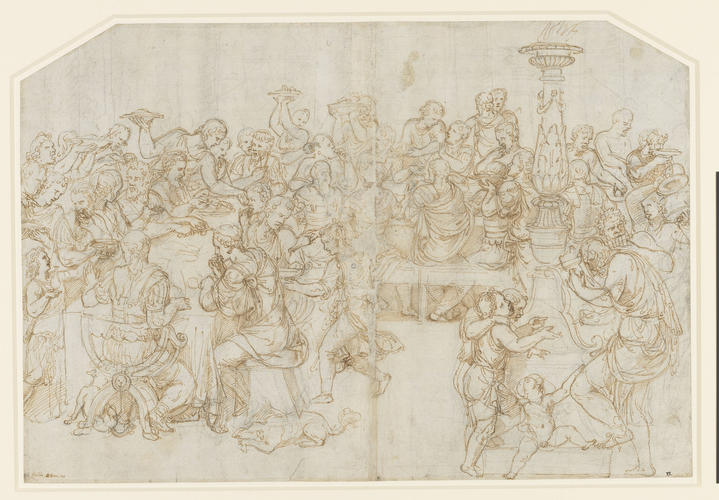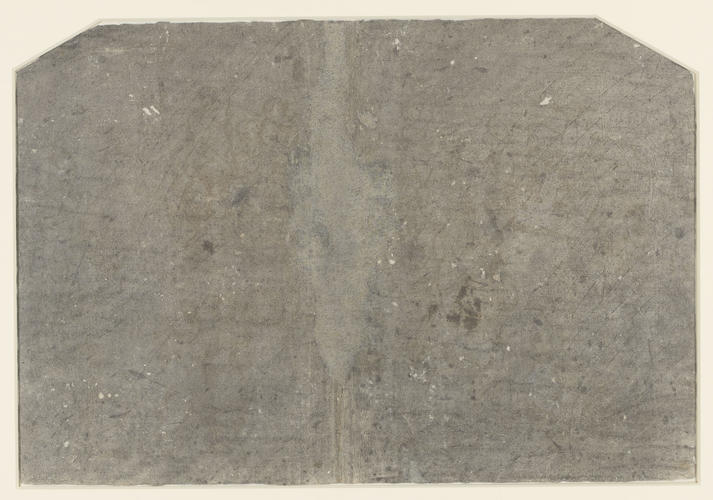-
1 of 253523 objects
The Triumphal Feast of Scipio c. 1532
Pen and ink over black chalk, the outlines indented with a stylus and the verso rubbed with black chalk. Watermark of an anchor in a circle with a five-petalled flower | 37.4 x 54.8 cm (sheet of paper) | RCIN 991367
-
A drawing of many Roman soldiers seated at a banquet, with other figures gathered around.
The drawing is a study for one of a series of 22 tapestries of the life of the Roman general Scipio Africanus, woven to the designs of Giulio Romano. The tapestries were made in Brussels, and the project was apparently commenced speculatively in the late 1520s by the Brussels entrepreneur Marc Crétif, with 12 scenes of the Acts of Scipio (scenes from his military campaigns, etc). On 11 July 1532 the French king Francis I commissioned the continuation of the series with a further ten scenes of the Triumph of Scipio, and payments continued until April 1535.
The original tapestries remained in the French royal collection until 1797, when they were burnt to recover their precious metals, but their compositions are known from the drawings and subsequent copies, from contemporary prints, and from later tapestries woven from the same cartoons. Giulio Romano is not linked to the project by any primary document, but a tradition dating back at least to the seventeenth century, inscriptions on the contemporary engravings, and most conclusively the style of several surviving preparatory drawings render his participation certain.
The tapestry corresponding with the present drawing was described in an inventory of the seventeenth century as the feast given by Scipio for the Roman tribunes who had been sent to Sicily to examine his conduct, and thus one of the Acts (transcribed in F. Reiset, Notices des dessins…, Paris 1866, p. 244). F. Hartt instead identified the subject as the feast held by Scipio for his friends at the Capitol at the end of his triumphal procession following the Second Punic War, and thus the last of the Triumphs (Giulio Romano, New Haven 1958, pp. 227ff).
So far as they go, the poses of all the figures here agree exactly with those in the final design, with the exceptions of the child seated on the huge candelabrum (who was to be eliminated) and a man in the right background. The candelabrum acts as a counterweight to direct attention towards Scipio, who is otherwise rather inconspicuous at the left with his back to the spectator. In the tapestry he is more easily identifiable as he wears a laurel wreath, a feature also seen in an etching of 1543 of the composition by Antonio Fantuzzi (Bartsch XVI, p. 349, no. 28), who must have had access to the tapestry cycle through his work at the French court.
The fully-worked modello for the composition, in which the architecture and background figures were elaborated, is at Chantilly. That modello is on the same scale as the present drawing, which is blackened on the verso: Giulio evidently transferred the design to the Chantilly sheet by pressing around the outlines here with a stylus, a procedure that he used often. Unlike Raphael's earlier work for the Sistine Chapel tapestries, Giulio designed the compositions in the intended direction of the tapestries. The two surviving full-size cartoons for the Scipio cycle (in the Louvre and the Hermitage) confirm that the required reversal took place when scaling up the modelli to the cartoons. Those cartoons were not painted by Giulio’s workshop, but were prepared in Brussels on the basis of the smaller modelli sent by Giulio from Mantua.
Whereas a modello by Giulio survives for every one of the Triumphs of Scipio, no autograph drawings by Giulio for the Acts are known (assuming that it is correct to dissociate the present design from the Acts and place it with the Triumphs). A suite of five modelli for the Acts entered the Louvre from the Jabach collection in 1671 with a persuasive attribution to Gianfrancesco Penni, who had by 1528 moved to Mantua to work alongside Giulio, but all that we know about Penni suggests that he would have been incapable of devising such extravagant compositions. It would appear that the difference between the two cycles was simply one of delegation: the modelli for the Acts were prepared by Penni to Giulio's designs around 1528, whereas four years later, after Penni had left the studio, the modelli for the Triumphs were drawn by Giulio himself. Perhaps Giulio's personal preparation of the latter series was due to the increased prestige of the commission after the French king became involved.Inscribed lower left, pen and ink: Julio Romano.
Provenance
From the collection of Sir Peter Lely (his stamp, Lugt 2092). Listed in George III's 'Inventory A' of c.1810, p. 52, Guilio [sic] Romano, Polidoro, e Perino del Vaga, Tom. 2, no. 9, 'a Composition for a large Feast...Guilio Romano'.
-
Creator(s)
-
Medium and techniques
Pen and ink over black chalk, the outlines indented with a stylus and the verso rubbed with black chalk. Watermark of an anchor in a circle with a five-petalled flower
Measurements
37.4 x 54.8 cm (sheet of paper)
Markings
watermark: anchor in a circle with five0lobed flower
Category
Object type(s)

